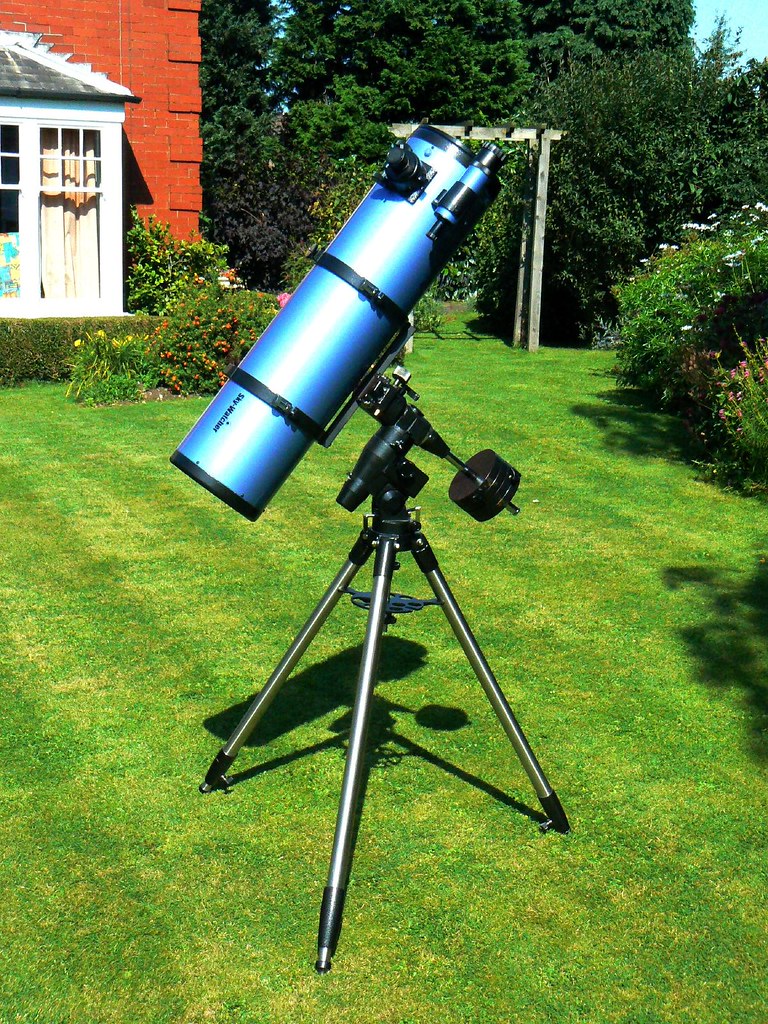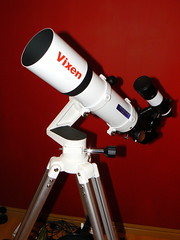Equipment
This page details the equipment I use for observing and photographing the night sky.
Main Telescope - Sky-Watcher Explorer 200 EQ5
This is the centre of my observing set-up. A 8" Newtonian reflector on an equatorial mount. It combines large aperture for collecting lots of light (enabling good views of faint fuzzies) with an equatorial mount that has a clock drive for tracking objects.
- Configuration - Newtonian Reflector (Parabolic)
- Aperture - 200mm (8")
- Focal length - 1000mm
- F/ratio - f/5
- Mount - Equatorial (EQ5) - with belt drive and GoTo mods
Current accessories:
- 9x50 Finderscope
- 25mm Plossl Eyepiece
- 10mm Plossl Eyepiece
- Celestron Ultima 2x Barlow
- Cheshire Collimating Eyepiece
- Polar Alignment Scope
So far this telescope has proved an excellent tool for observing all sort of objects in the sky. With its large field of view it provides stunning views of open clusters (including my favourite, the Double Cluster in Perseus) as well as spectacular views of Saturn and Jupiter during moments of steady seeing. With its large aperture dim objects such as the Andromeda Galaxy reveal a great amount of detail, and pushing it through the Coma-Virgo Cluster is quite amazing with galaxies peppering the view. I would definitely recommend it for people looking for a capable all-round instrument.
Secondary Telescope - Vixen ED80sf Porta-Mount
My new telescope purchased in October 2008. This compliments the 8" Newtonian being smaller, lighter and therefore better suited to grab-and-go observing in Scotland.
- Configuration - Refractor (Apochromatic Doublet)
- Aperture - 80mm (3.5")
- Focal length - 600mm
- F/ratio - f/7.5
- Mount - Alt-Az (Vixen Porta-Mount)
Current accessories:
- 9x50 Finderscope
- 30mm Ultrawide 2" Eyepiece
- Dielectric Coated 2" Diagonal
The 2" diagonal comes with a 2" to 1.25" reducer such that I can use my Plossl eyepieces with the refractor.
This is my portable observing set-up. With this set-up I can take everything out to my observing location in one trip and have it set-up ready to observe in a matter of minutes. It will also travel by car and gives a good range of views from rich star fields through to the Moon and planets. It lacks the aperture of the Newt but has excellent optics and I am now using it as the primary lens for my astro-imaging efforts.
Camera - Canon 450D
This is the first SLR I have owned. Primarily it is used for taking landscape shots whilst out in the Scottish mountains, but it has also proved useful as an astro camera for widefield shots, ISS passes and as the prime device for taking deep sky astrophotographs through the Vixen refractor.
- 12 MegaPixels CCD
- Bulb mode for long exposures
- Mirror lock-up for long exposures
- Canon Live View
- Kit Zoom Lens - 18-55mm
- Kit Lens Aperture - f/2.8 to f/22
Camera - Canon 6D
This is my full frame dSLR used primarily for landscape and landscape astrophotography.
- 20.2 MegaPixels CCD
- Full Frame
- Up to ISO 25600
- Bulb mode for long exposures
- Mirror lock-up for long exposures
- Canon Live View
Camera - Panasonic DMC-FZ7
With a Leica DC Vario-Elmarit Lens this is a very nice bridge camera that packs a lot of features (including 12x optical zoom) into a very compact package. Although it performs best under nice, sunny conditions I have used it with some success to take sky shots as well as documenting lunar eclipses and atmospheric phenomena. It also has a good image stabalisation feature and can accept accessories such as polarising filters and wide-angle lenses. It is lightweight making it good for tripod work and has produced some stunning results with Noctilucent Clouds.
- 6 MegaPixels CCD
- 12x Optical Zoom
- 4x Digital Zoom
- 2" LCD monitor
- Focal length 36-432mm (35mm equivalent)
- Aperture f/2.8 to f/8
Binoculars - Celestron SkyMaster 15x70
Binoculars are an essential item in any astronomers set-up. They enable wide field of views that are useful when searching for hard to find objects. They are also the best pick up and go accessory for nights that are too changeable to merit setting up the telescope. I always have them with me so that I can sweep the sky or take a look at interesting objects. One of the best views in them is the open star cluster, M45, the Pleiades.

